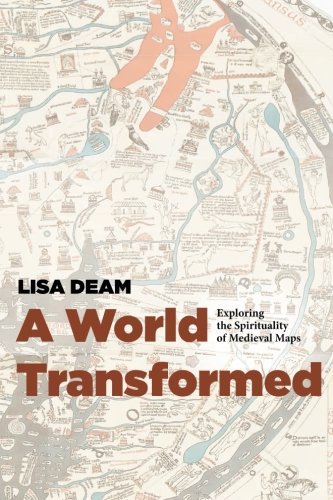 With Jerusalem and Jesus’ crucifixion at its center, the Hereford Map orients East at the top, England in the lower left, and monsters at the edges. Created around the year 1300, it depicts the history, geography, and destiny of the world according to medieval Christianity. A single sheet of vellum measuring 5’ 2” high by 4’ 4” wide displays its artistry. The original viewers were pilgrims to England’s Hereford Cathedral, some of whom made the pilgrimage annually. Hereford Cathedral still displays the map year round.
With Jerusalem and Jesus’ crucifixion at its center, the Hereford Map orients East at the top, England in the lower left, and monsters at the edges. Created around the year 1300, it depicts the history, geography, and destiny of the world according to medieval Christianity. A single sheet of vellum measuring 5’ 2” high by 4’ 4” wide displays its artistry. The original viewers were pilgrims to England’s Hereford Cathedral, some of whom made the pilgrimage annually. Hereford Cathedral still displays the map year round.
Lisa Deam holds a Ph.D. in medieval art from Chicago University. Attempting to maintain a scholarly eye while writing her dissertation on the Hereford Map, Deam discovered “that there was really no way to separate medieval art from medieval faith and spirituality — and from my own faith.” (1) The crossroads of Deam’s scholarly work and her Christian faith has resulted in, A World Transformed: Exploring the World of Medieval Spirituality.
I finished reading the Introduction of A World Transformed in May of this year as rainy skies cleared and the sun shone through. Deam invites the reader to “travel these paths with me. Together, we will be pilgrims on a journey.” (11) I couldn’t help but be reminded of a few lines from The Canterbury Tales’ Prologue:
“Whan that aprill with his shoures soote
“The droghte of march hath perced to the roote,
“….
“Thanne longen folk to goon on pilgrimages”Translation: “When April with his showers sweet with fruit
“The drought of March has pierced unto the root
“….
“Then do folk long to go on pilgrimage”
(The Canterbury Tales Prologue 1, 2, 12)
Traveling with Deam through a study of medieval maps is a fruitful, satisfying journey toward understanding how medieval spirituality can inform and enlarge today’s practice of Christianity.
[Read my full review at Englewood Review of Books]
